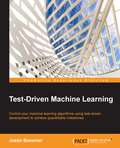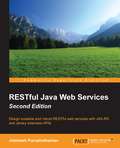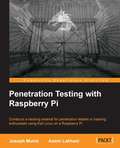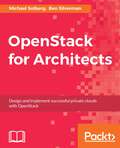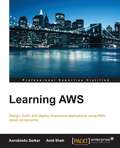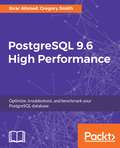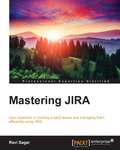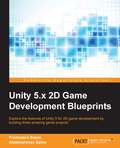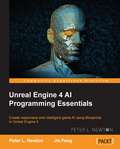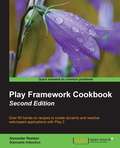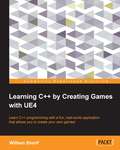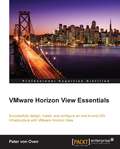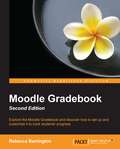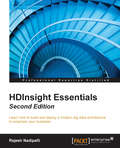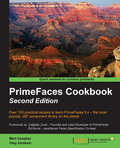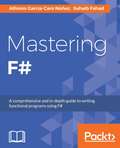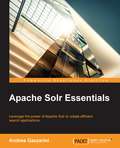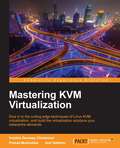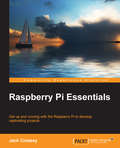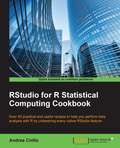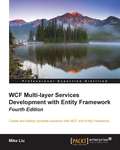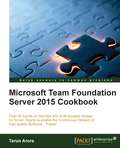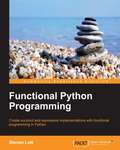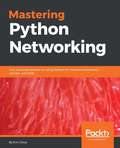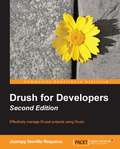- Table View
- List View
Test-Driven Machine Learning
by Justin BozonierThis book is intended for data technologists (scientists, analysts, or developers) with previous machine learning experience who are also comfortable reading code in Python. You may be starting, or have already started, a machine learning project at work and are looking for a way to deliver results quickly to enable rapid iteration and improvement. Those looking for examples of how to isolate issues in models and improve them will find ideas in this book to move forward.
RESTful Java Web Services - Second Edition
by Jobinesh PurushothamanDesign scalable and robust RESTful web services with JAX-RS and Jersey extension APIs About This Book * Get to grips with the portable Java APIs used for JSON processing * Design solutions to produce, consume, and visualize RESTful web services using WADL, RAML, and Swagger * A step-by-step guide packed with many real-life use-cases to help you build efficient and secure RESTful web APIs in Java Who This Book Is For If you are a web developer with a basic understanding of the REST concepts but are new to the idea of designing and developing RESTful web services, this is the book for you. As all the code samples for the book are written in Java, proficiency in Java is a must. What You Will Learn * Introduce yourself to the RESTful software architectural style and the REST API design principles * Make use of the JSR 353 APIs and Jackson API for JSON processing * Build portable RESTful web APIs, making use of the JAX-RS 2.0 API * Simplify API development using the Jersey extension APIs * Secure your RESTful web services with various authentication and authorization mechanisms * Get to grips with the various metadata solutions to describe, produce, and consume RESTful web services * Understand the design and coding guidelines to build well-performing RESTful APIs * See how the role of RESTful web services changes with emerging technologies and trends In Detail REST (REpresentational State Transfer) is a simple yet powerful software architecture style to create scalable web services and allow them to be simple, lightweight, and fast. The REST API uses HTTP and JSON, so that it can be used with many programming languages such as Ruby, Java, Python, and Scala. Its use in Java seems to be the most popular though, because of the API's reusability. This book is a guide to developing RESTful web services in Java using the popular RESTful framework APIs available today. You will begin with gaining an in-depth knowledge of the RESTful software architectural style and its relevance in modern applications. Further, you will understand the APIs to parse, generate, transform, and query JSON effectively. Then, you will see how to build a simple RESTful service using the popular JAX-RS 2.0 API along with some real-world examples. This book will introduce you to the Jersey framework API, which is used to simplify your web services. You will also see how to secure your services with various authentication mechanisms. You will get to grips with various solutions to describe, produce, consume, and visualize RESTful web services. Finally, you will see how to design your web services to equip them for the future technological advances, be it Cloud or mobile computing. By the end of this book, you will be able to efficiently build robust, scalable, and secure RESTful web services, making use of the JAX-RS and Jersey framework extensions. Style and approach This book is written as a step-by-step guide to designing and developing robust RESTful web services. Each topic is explained in a simple and easy-to-understand manner with lots of real-life use-cases and their solutions.
Penetration Testing with Raspberry Pi
by Joseph Muniz Aamir LakhaniIf you are looking for a low budget, small form-factor remotely accessible hacking tool, then the concepts in this book are ideal for you. If you are a penetration tester who wants to save on travel costs by placing a low-cost node on a target network, you will save thousands by using the methods covered in this book. You do not have to be a skilled hacker or programmer to use this book. It will be beneficial to have some networking experience; however, it is not required to follow the concepts covered in this book.
OpenStack for Architects
by Ben Silverman Michael SolbergDesign and implement successful private clouds with OpenStack About This Book • Explore the various design choices available for cloud architects within an OpenStack deployment • Craft an OpenStack architecture and deployment pipeline to meet the unique needs of your organization • Create a product roadmap for Infrastructure as a Service in your organization using this hands-on guide Who This Book Is For This book is written especially for those who will design OpenStack clouds and lead their implementation. These people are typically cloud architects, but may also be in product management, systems engineering, or enterprise architecture. What You Will Learn • Familiarize yourself with the components of OpenStack • Build an increasingly complex OpenStack lab deployment • Write compelling documentation for the architecture teams within your organization • Apply Agile configuration management techniques to deploy OpenStack • Integrate OpenStack with your organization's identity management, provisioning, and billing systems • Configure a robust virtual environment for users to interact with • Use enterprise security guidelines for your OpenStack deployment • Create a product roadmap that delivers functionality quickly to the users of your platform In Detail Over the last five years, hundreds of organizations have successfully implemented Infrastructure as a Service (IaaS) platforms based on OpenStack. The huge amount of investment from these organizations, industry giants such as IBM and HP, as well as open source leaders such as Red Hat have led analysts to label OpenStack as the most important open source technology since the Linux operating system. Because of its ambitious scope, OpenStack is a complex and fast-evolving open source project that requires a diverse skill-set to design and implement it. This guide leads you through each of the major decision points that you'll face while architecting an OpenStack private cloud for your organization. At each point, we offer you advice based on the experience we've gained from designing and leading successful OpenStack projects in a wide range of industries. Each chapter also includes lab material that gives you a chance to install and configure the technologies used to build production-quality OpenStack clouds. Most importantly, we focus on ensuring that your OpenStack project meets the needs of your organization, which will guarantee a successful rollout. Style and approach This is practical, hands-on guide to implementing OpenStack clouds, where each topic is illustrated with real-world examples and then the technical points are proven in the lab.
Learning AWS
by Amit Shah Aurobindo SarkarThis book is targeted at expert programmers and architects wanting to learn AWS. Some familiarity with Spring, MySQL, and RESTful web services is assumed.
PostgreSQL 9.6 High Performance
by Gregory Smith Ibrar AhmedEnhance the performance of your PostgreSQL system with this handy guide while avoiding common pitfalls that can slow it down. About This Book • Learn the right techniques to obtain optimal PostgreSQL database performance, ranging from initial design to routine maintenance • Fine tune the performance of your queries and avoid the common pitfalls that can slow your system down • Contains tips and tricks on scaling successful database installations, and ensuring a highly available PostgreSQL solution Who This Book Is For This book is for intermediate to advanced database administrators and developers who use or plan to exploit the features of PostgreSQL in the best possible manner. While administrators can benefit from the topics related to the installation, configuration, and optimization of the server, developers will learn how to write optimal queries and address performance issues in their database design. This book will also benefit the PostgreSQL internal architects in being able to monitor the performance using benchmarking tools. What You Will Learn • Learn the best practices to configure your PostgreSQL 9.6 database for optimal performance • Write optimal queries and techniques to detect performance issue in queries • Fine tune the performance of your queries using benchmarking and indexing techniques • Ensure high performance and a highly available database using the scaling and replication techniques • Discover how to make informed speed and reliability trade-offs • Handle increasing database workloads without any hassle • Use monitoring insights to continuously rework the design and configuration for best performance In Detail Database administrators and developers spend years learning techniques to configure their PostgreSQL database servers for optimal performance, mostly when they encounter performance issues. Scalability and high availability of the database solution is equally important these days. This book will show you how to configure new database installations and optimize existing database server installations using PostgreSQL 9.6. You will start with the basic concepts of database performance, because all successful database applications are destined to eventually run into issues when scaling up their performance. You will not only learn to optimize your database and queries for optimal performance, but also detect the real performance bottlenecks using PostgreSQL tools and some external tools. Next, you will learn how to benchmark your hardware and tune your operating system. Optimize your queries against the database with the help of right indexes, and monitor every layer, ranging from hardware to queries. Moving on, you will see how connection pooling, caching, partitioning, and replication will help you handle increasing database workloads. Achieving high database performance is not easy, but you can learn it by using the right guide—PostgreSQL 9.6 High Performance. Style and approach This book has been organized in such a manner that will help you understand basic PostgreSQL 9.6 performance tuning to advanced-level configuration. There are many real-world problems explained in this book and explained in clear language, because improving database performance requires an equal mix of understanding theoretical concepts and working through hands-on examples.
Mastering JIRA
by Ravi Sagar<P><P>Gain expertise in tracking project issues and managing them efficiently using JIRA <P><P>About This Book <P><P>Customize JIRA for a variety of applications such as software project management, Agile tracking, and test management with the help of sample data to get you started <P><P>Deploy big JIRA instances by planning the installations for Enterprise <P><P>A comprehensive guide on JIRA with an easy-to-learn structure to help you become the go-to person for JIRA in your organization <P><P>Who This Book Is For <P><P>If you are a JIRA administrator managing small-to-medium JIRA instances and want to learn how to manage enterprise-scale instances, then this book will help you expand your knowledge and equip you with advanced skills. Prior understanding of JIRA core concepts is required. <P><P>What You Will Learn <P><P>Plan the installation and upgrade of your JIRA instance <P><P>Configure issue type schemes, create customized workflows, modify permission schemes, and change notification schemes <P><P>Customize JIRA for test management, helpdesk, and requirement management <P><P>Deploy JIRA for Agile tracking using the Scrum and Kanban techniques <P><P>Manage users and groups and integrate them with LDAP for single sign-on <P><P>Develop JIRA add-ons to extend JIRA's functionality <P><P>Migrate data from external systems using CSV import <P><P>Generate reports directly from the JIRA database and to use custom JavaScript and CSS <P><P>In Detail <P><P>JIRA is an issue-tracking tool from Atlassian and has gained immense popularity in recent years due to its ease of use and, at the same time, its customization abilities and finely grained control over various functions. JIRA offers functionalities for creating tasks and assigning them to users and many useful add-ons can be added such as JIRA Agile for Agile tracking and Groovy scripts, a powerful tool for administering customizations for customizations. <P><P>This book explains how to master the key functionalities of JIRA and its customizations and add-ons, and is packed with real-world examples and use cases. You will first learn how to plan JIRA installation. Next, you will be given a brief refresher of fundamental concepts and learn about customizations in detail. Next, this book will take you through add-on development to extend JIRA functionality. Finally, this book will explore best practices and troubleshooting, to help you find out what went wrong and how to fix it.
Unity 5.x 2D Game Development Blueprints
by Abdelrahman Saher Francesco SapioIf you've got the basics of 2D development down, push your skills with the projects in this hands-on guide. Diversify your portfolio and learn the skills to build a range of awesome 2D game genres.
Unreal Engine 4 AI Programming Essentials
by Peter L. Newton Jie FengCreate responsive and intelligent game AI using Blueprints in Unreal Engine 4 About This Book * Understand and apply your Game AI better through various projects such as adding randomness and probability, and introducing movement * Configure and debug Game AI logic using multiple methodologies * Bridge the gap between your knowledge and Game AI in Unreal Engine 4 Who This Book Is For This book is for programmers and artists who want to expand their knowledge of Game AI in relation to Unreal Engine 4. You are recommended to have some experience of exploring Unreal Engine 4 prior to this book because we jump straight into Game AI. What You Will Learn * Understand the fundamental components of Game AI within Unreal Engine 4 * Skillfully introduce Game AI within Unreal Engine 4 * Configure, customize, and assign Navigation and AI components to your pawn * Create, debug, and analyze Game AI behavior * Design responsive Game AI using the Behavior Tree methodology * Create smart objects designed to interact with AI * Utilize advanced AI features within your project to maximize the user experience In Detail Unreal Engine is a powerful game development engine that provides rich functionalities to create 2D and 3D games. It is one of the three big game engines used, alongside Unity and CryEngine. Developers have the opportunity to build cross-platform mobile and desktop games from scratch. With Blueprints in Unreal Engine 4, you're able to fully leverage the visual aid that Behavior Trees are built on. Rarely has there been an opportunity to prototype powerful Game AI and have immediate control over constructing, scripting, and viewing the response in a live gaming environment. This book will show you how to apply artificial intelligence (AI) techniques to your Unreal Script using C++ as your scripting language through multiple projects. With the knowledge gained through this book, you'll be able to leverage the benefits of Unreal Engine 4. We'll start with an introduction to AI, and you'll learn how it is applied to gaming. Then you'll jump right in and create a simple AI bot and apply basic behaviors to allow it to move randomly. Furthermore, you will get to know the difference between an AI Controller and a Player Controller. As you progress, you'll find out how to implement randomness and probability traits. Using Navmesh, we will impart navigation components such as Character Movement, MoveTo Nodes, Settings, and World Objects, and implement behavior trees. You will see different techniques to sense the environment and create your own sensory system, and will implement Steering Behaviors, Path Following, Avoidance, and Projectiles. At the end of the book, we will troubleshoot any issues that might crop up while building the entire game. Style and approach This easy-to-follow project-based guide throws you directly into the excitement of Game AI in an approachable and comprehensive manner.
Play Framework Cookbook - Second Edition
by Alexander Reelsen Giancarlo InductivoThis book is aimed at advanced developers who are looking to harness the power of Play 2.x. This book will also be useful for professionals looking to dive deeper into web development. Play 2 .x is an excellent framework to accelerate your learning of advanced topics.
Learning C++ by Creating Games with UE4
by William Sherif<P><P>Learn C++ programming with a fun, real-world application that allows you to create your own games! <P><P>About This Book <P><P>Be a top programmer by being able to visualize programming concepts; how data is saved in computer memory, and how a program flows <P><P>Keep track of player inventory, create monsters, and keep those monsters at bay with basic spell casting by using your C++ programming skills within Unreal Engine 4 <P><P>Understand the C++ programming concepts to create your own games <P><P>Who This Book Is For <P><P>If you are really passionate about games and have always wanted to write your own, this book is perfect for you. It will help you get started with programming in C++ and explore the immense functionalities of UE4. <P><P>What You Will Learn <P><P>Visualize and truly understand C++ programming concepts, such as how data is saved in computer memory and how program flow works <P><P>Write reusable code by grouping lines of code into functions <P><P>Learn how inheritance works-how traits of a base class are passed on to derived classes <P><P>Learn about dynamic allocation of new memory for your program <P><P>Design your own world using the UE4 editor <P><P>Practice programming by coding behaviors into your game world, including player inventory tracking, monsters, and NPCs <P><P>In Detail <P><P>Unreal Engine 4 is used to create top notch, exciting games by AAA studios, and learning to program in C++ needs some serious motivation. <P><P>Learning C++ by Creating Games With UE4 will start with the basics of C++: installing a code editor so you can begin to write C++ code. You will then learn how to write small, self-contained C++ programs that show you how to use the C++ language, without overwhelming you with too much code at the beginning. As we dig into more advanced C++ concepts, you will start to explore the functionality the UE4 engine has to offer. You will use the UE4 editor to create your own world, and then program in some seriously fun gameplay. By the end of this book, you should have a good grasp of how to program in C++.
VMware Horizon View Essentials
by Peter Von OvenIf you are a desktop administrator or an end user of a computing project team looking to speed up to the latest VMware Horizon View solution, then this book is perfect for you. It is your ideal companion to deploy a solution to centrally manage and virtualize your desktop estate using Horizon View 6.0.
Moodle Gradebook - Second Edition
by Rebecca BarringtonThis book is for teachers and administrators who have experience with Moodle. Basic knowledge of Moodle 2.x will be required, but no prior knowledge of grade functions is needed. This book will help you utilize the full functionality of Version 2.7.
HDInsight Essentials - Second Edition
by Rajesh NadipalliIf you want to discover one of the latest tools designed to produce stunning Big Data insights, this book features everything you need to get to grips with your data. Whether you are a data architect, developer, or a business strategist, HDInsight adds value in everything from development, administration, and reporting.
PrimeFaces Cookbook - Second Edition
by Mert Calıskan Oleg VaraksinThis book is for everybody who would like to learn modern Java web development based on PrimeFaces and is looking for a quick introduction to this matter. Prerequisites for this book are basic JSF, jQuery, and CSS skills.
Mastering F#
by Suhaib Fahad Alfonso Garcia-Caro NunezA comprehensive and in-depth guide to writing functional programs using F# About This Book * Learn how to manage, run, and automate your servers using Puppet * Explore how to use F# to develop large-scale applications quickly and simply, and become more productive in today's age of cloud computing and multi-core programming * This easy-to-follow guide is packed with real-world examples that will jump-start you with F# development on the .NET platform Who This Book Is For If you are a C# developer with a basic knowledge of F# and want to explore the functional programming paradigm further to master your F# skills, then this book is for you. What You Will Learn * Understand the basics of F# and organize F# source code with Visual Studio * Work with F# data structures and create functional data structures in F# interoperate with C# * Build and use asynchronous programming patterns with F# * Create and use type providers that help perform data analysis from within Visual Studio * Develop applications with pure F# code in WPF or ASP.NET MVC * Find out how to perform distributed programming with ServiceBus or ZeroMQ * Visualize data with charts, and work with Excel and R language Type providers In Detail F# is a multi-paradigm programming language that encompasses object-oriented, imperative, and functional programming language properties. Now adopted in a wide range of application areas and is supported both by industry-leading companies who provide professional tools and by an active open community, F# is rapidly gaining popularity as it emerges in digital music advertising, creating music-focused ads for Spotify, Pandora, Shazam, and anywhere on the web. This book will guide you through the basics and will then help you master F#. The book starts by explaining how to use F# with Visual Studio, file ordering, and the differences between F# and C# in terms of usage. It moves on to explain the functional core of F# such as data types, type declarations, immutability, strong type interference, pattern matching, records, F# data structures, sequence expressions, and lazy evaluation. Next, the book takes you through imperative and asynchronous programming, F# type providers, applications, and testing in F#. Finally, we look into using F# with distributed programming and using F# as a suitable language for data science. In short, this book will help you learn F# for real-world applications and increase your productivity with functional programming. Style and approach This easy-to-follow guide with syntaxes will help you master the concepts of F#. Packed with in-depth examples of real-world uses, this book covers each topic in detail with a reference to C#, so you will understand the difference between the languages.
Apache Solr Essentials
by Andrea GazzariniIf you are a competent developer with experience of working with technologies similar to Apache Solr and want to develop efficient search applications, then this book is for you. Familiarity with the Java programming language is required.
Mastering KVM Virtualization
by Prasad Mukhedkar Humble Devassy Chirammal Anil VettathuDive in to the cutting edge techniques of Linux KVM virtualization, and build the virtualization solutions your datacentre demands About This Book * Become an expert in Linux virtualization * Migrate your virtualized datacenter to the cloud * Find out how to build a large scale virtualization solution that will transform your organization Who This Book Is For Linux administrators - if you want to build incredible, yet manageable virtualization solutions with KVM this is the book to get you there. It will help you apply what you already know to some tricky virtualization tasks. What You Will Learn * Explore the ecosystem of tools that support Linux virtualization * Find out why KVM offers you a smarter way to unlock the potential of virtualization * Implement KVM virtualization using oVirt * Explore the KVM architecture - so you can manage, scale and optimize it with ease * Migrate your virtualized datacenter to the cloud for truly resource-efficient computing * Find out how to integrate OpenStack with KVM to take full control of the cloud In Detail A robust datacenter is essential for any organization - but you don't want to waste resources. With KVM you can virtualize your datacenter, transforming a Linux operating system into a powerful hypervisor that allows you to manage multiple OS with minimal fuss. This book doesn't just show you how to virtualize with KVM - it shows you how to do it well. Written to make you an expert on KVM, you'll learn to manage the three essential pillars of scalability, performance and security - as well as some useful integrations with cloud services such as OpenStack. From the fundamentals of setting up a standalone KVM virtualization platform, and the best tools to harness it effectively, including virt-manager, and kimchi-project, everything you do is built around making KVM work for you in the real-world, helping you to interact and customize it as you need it. With further guidance on performance optimization for Microsoft Windows and RHEL virtual machines, as well as proven strategies for backup and disaster recovery, you'll can be confident that your virtualized data center is working for your organization - not hampering it. Finally, the book will empower you to unlock the full potential of cloud through KVM. Migrating your physical machines to the cloud can be challenging, but once you've mastered KVM, it's a little easie. Style and approach Combining advanced insights with practical solutions, Mastering KVM Virtualization is a vital resource for anyone that believes in the power of virtualization to help a business use resources more effectively.
Raspberry Pi Essentials
by Jack CreaseyProgrammers new to the Raspberry Pi and novice programmers with little to no experience with micro board computing will find the book useful. A basic knowledge of programming languages in general will prove useful for a better understanding of the topics.
RStudio for R Statistical Computing Cookbook
by Andrea CirilloOver 50 practical and useful recipes to help you perform data analysis with R by unleashing every native RStudio feature About This Book * 54 useful and practical tasks to improve working systems * Includes optimizing performance and reliability or uptime, reporting, system management tools, interfacing to standard data ports, and so on * Offers 10-15 real-life, practical improvements for each user type Who This Book Is For This book is targeted at R statisticians, data scientists, and R programmers. Readers with R experience who are looking to take the plunge into statistical computing will find this Cookbook particularly indispensable. What You Will Learn * Familiarize yourself with the latest advanced R console features * Create advanced and interactive graphics * Manage your R project and project files effectively * Perform reproducible statistical analyses in your R projects * Use RStudio to design predictive models for a specific domain-based application * Use RStudio to effectively communicate your analyses results and even publish them to a blog * Put yourself on the frontiers of data science and data monetization in R with all the tools that are needed to effectively communicate your results and even transform your work into a data product In Detail The requirement of handling complex datasets, performing unprecedented statistical analysis, and providing real-time visualizations to businesses has concerned statisticians and analysts across the globe. RStudio is a useful and powerful tool for statistical analysis that harnesses the power of R for computational statistics, visualization, and data science, in an integrated development environment. This book is a collection of recipes that will help you learn and understand RStudio features so that you can effectively perform statistical analysis and reporting, code editing, and R development. The first few chapters will teach you how to set up your own data analysis project in RStudio, acquire data from different data sources, and manipulate and clean data for analysis and visualization purposes. You'll get hands-on with various data visualization methods using ggplot2, and you will create interactive and multidimensional visualizations with D3.js. Additional recipes will help you optimize your code; implement various statistical models to manage large datasets; perform text analysis and predictive analysis; and master time series analysis, machine learning, forecasting; and so on. In the final few chapters, you'll learn how to create reports from your analytical application with the full range of static and dynamic reporting tools that are available in RStudio so that you can effectively communicate results and even transform them into interactive web applications. Style and approach RStudio is an open source Integrated Development Environment (IDE) for the R platform. The R programming language is used for statistical computing and graphics, which RStudio facilitates and enhances through its integrated environment. This Cookbook will help you learn to write better R code using the advanced features of the R programming language using RStudio. Readers will learn advanced R techniques to compute the language and control object evaluation within R functions. Some of the contents are: * Accessing an API with R * Substituting missing values by interpolation * Performing data filtering activities * R Statistical implementation for Geospatial data * Developing shiny add-ins to expand RStudio functionalities * Using GitHub with RStudio * Modelling a recommendation engine with R * Using R Markdown for static and dynamic reporting * Curating a blog through RStudio * Advanced statistical modelling with R and RStudio
WCF Multi-layer Services Development with Entity Framework - Fourth Edition
by Mike LiuIf you are a C#, VB.NET, or C++ developer and want to get started with WCF and Entity Framework, then this book is for you. Competence in Entity Framework will be needed to follow the examples in the book, but experience in creating WCF services using Entity Framework is not necessary. Developers and architects evaluating SOA implementation technologies for their company will find this book useful.
Microsoft Team Foundation Server 2015 Cookbook
by Tarun AroraOver 80 hands-on DevOps and ALM-focused recipes for Scrum Teams to enable the Continuous Delivery of high-quality Software... Faster! About This Book * Release high quality, reliable software quickly through building, testing, and deployment automation * Improve the predictability, reliability, and availability of TFS in your organization by scheduling administration and maintenance activities * Extend, customize, and integrate tools with TFS, enabling your teams to manage their application lifecycles effectively Who This Book Is For This book is aimed at software professionals including Developers, Testers, Architects, Configuration Analysts, and Release Managers who want to understand the capabilities of TFS to deliver better quality software faster. A working setup of TFS 2015 and some familiarity with the concepts of software life cycle management is assumed. What You Will Learn * Creating a Team Project with Dashboards, Assigning License, Adding users, and Auditing Access * Setting up a Git repository in an existing TFVC-based Team Project * Setting up branch policies and conducting Pull requests with code reviews * Mapping, assigning and tracking work items shared by multiple teams * Setting up and customizing Backlogs, Kanban board, Sprint Taskboard, and dashboards * Creating a Continuous Integration, Continuous Build, and Release Pipeline * Integrating SonarQube with TFBuild to manage Technical Debt * Triggering Selenium Web Tests on a Selenium Test Grid using TFBuild * Using Visual Studio Team Services Cloud load testing capability with new Build framework * Extending and customizing the capabilities of Team Foundation Server using API and Process Editor In Detail Team Foundation Server (TFS) allows you to manage code repositories, build processes, test infrastructure, and deploy labs. TFS supports your team, enabling you to connect, collaborate, and deliver on time. Microsoft's approach to Application Lifecycle Management (ALM) provides a flexible and agile environment that adapts to the needs of your team, removes barriers between roles, and streamlines processes. The book introduces you to creating and setting up team projects for scrum teams. You'll explore various source control repositories, branching, and merging activities, along with a demonstration of how to embed quality into every code check-in. Then, you'll discover agile project planning and management tools. Later, emphasis is given to the testing and release management features of TFS which facilitate the automation of the release pipeline in order to create potentially shippable increments. By the end of the book, you'll have learned to extend and customize TFS plugins to incorporate them into other platforms and enable teams to manage the software lifecycle effectively. Style and approach This book is a recipe-based guide that uses a problem-solution format to call out inefficiencies in the software development lifecycle and then guides you, step-by-step, on how you can use Team Foundation Server to your advantage in those areas.
Functional Python Programming
by Steven Lott<P><P>Key Features <P><P>Implement common functional programming design patterns and techniques in Python <P><P>Learn how to choose between imperative and functional approaches based on expressiveness, clarity, and performance <P><P>Apply functional Python to common Exploratory Data Analysis (EDA) programming problems <P><P>Book Description <P><P>Python’s easy-to-learn and extensible abilities offer a number of functional programming features for you to bring into your workflow, especially in the realm of data science. <P><P>If you’re a Python developer who wants to discover how to take the power of functional programming and bring it into your own programs then this book is essential for you, even if you know next to nothing about the paradigm. Starting with a general overview of functional concepts you’ll explore common functional features such as first-class and higher-order functions, pure functions and more, and how these are accomplished in Python to give you the core foundations you’ll build upon. After that, you’ll discover common functional optimizations for Python to help your apps reach even higher speeds. You'll also explore data preparation techniques and data exploration in depth, along with learning how the Python standard library fits the functional programming model. Finally, to top off your journey into the world of function Python you’ll at look at the PyMonad project and some larger examples to put everything into perspective. <P><P>With Functional Python Programming by your side you’ll understand the core concepts of function Python, its impact on the programming workflow, and how to implement it in Python, giving you the ability to take your applications to an even higher level. <P><P>What you will learn <P><P>Use Python's generator functions and generator expressions to work with collections in a non-strict (or lazy) manner <P><P>Utilize Python library modules including itertools, functools, multiprocessing, and concurrent.futures for efficient functional programs <P><P>Use Python strings with object-oriented suffix notation and prefix notation <P><P>Avoid stateful classes by making use of families of tuples <P><P>Design and implement decorators to create composite functions <P><P>Use functions like max(), min(), map(), filter(), and sorted() <P><P>Write advanced higher-order functions
Mastering Python Networking: Your One-stop Solution To Using Python For Network Automation, Devops, And Test-driven Development, 2nd Edition
by Eric ChouPython is also an extension language for applications written in other languages that need easy-to-use scripting or automation interfaces. It is one of the easiest languages with which you can perform network automation. This book will cover all advanced networking concepts using Python.
Drush for Developers - Second Edition
by Juampy Novillo RequenaThis book is a best fit for backend developers with a basic knowledge of Drupal's APIs and some experience using the command line. Perhaps you already worked on one or two Drupal projects, but have never dived deep into Drush's toolset. In any case, this book will give you a lot of advice by covering real-world challenges in Drupal projects that can be solved using Drush.
